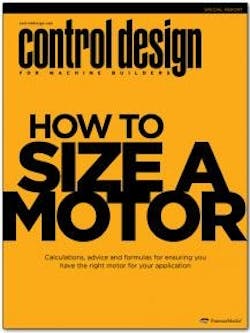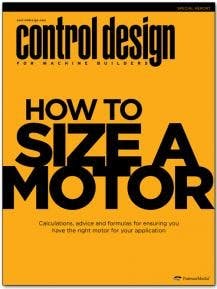How to size a motor
A Control Design reader wrote to us: "The multi-station dial indexers we build are in multiple diameters and different cycle rates. We have one basic design that is customized based on the needs of the application. How can we be sure we’re sizing the right type of motor correctly? The tables’ motors currently can vary from induction to servo.
We’re also thinking of adding a gear box or direct drive. What are the calculations we can use to determine which motor to use?"
We posed the question to a range of experts in the industry. Here's what they said ...
ANSWERS
Load inertia
The number one calculation to make when sizing a motor for a rotary application is the calculation of the load inertia. The more accurately this can be calculated, the better. To make this calculation, it’s generally best to approximate the load as a disc or cylinder. In the case of a dial indexer, this is fairly straightforward, since the dial is already essentially a disc shape and the load is typically evenly distributed around the dial. The basic load inertia calculation in SI units looks like this:
mr2/2
where:
m = the total mass of the dial, with all tooling included, in units of kg
r = the radius of the dial, in units of m or cm.
In English units the calculation looks like this:
Wr2/2g
where:
W = the total weigh of the dial, with all tooling included, in units of lbf
r = the radius of the dial, in units of in or ft
g = gravity constant, 386 in/sec2.
The result of this calculation will be in units of kg-m2 or kg-cm2 if using SI units, or units of in-lb-sec2 or ft-lb-sec2 if using English units.
With this load inertia calculation complete, it is possible to begin looking for an appropriate motor to rotate the dial. The most common rules of thumb are to look for a motor whose rotor inertia is no less than 1/5 or 1/10 the load inertia. If the dial is large, this may be near impossible, and this is where a gearbox becomes important.
The advantage of a gearbox is that it reduces the effective inertia of the load by the square of the gearbox ratio. For example a 25:1 gear ratio will reduce the effective load inertia by 252, or 625 times. This reduction in load inertia makes it much easier to find a suitable motor.
The trade-off of a gearbox is that it reduces the output speed of the motor/gearbox combination, so it is imperative that the maximum rotational speed and cycle time requirements of the application are also calculated. In the example above, if the 25:1 gear ratio in combination with the proposed motor’s rated speed indicate that the required output speed and cycle times are not achievable, a smaller gear ratio and larger motor, with larger rotor inertia, must be considered.
Another option is to go with a direct drive motor. This can often eliminate the need for a gearbox and increase overall performance by eliminating mechanical components, such as gearboxes, that can introduce backlash or other unwanted mechanical inaccuracies. However, integration of the direct drive motor is generally more complex than a standard motor and needs to be considered earlier in the design stage of the machine. It is also generally a more difficult process to retrofit an existing machine with a direct drive motor than a standard motor.
In conclusion, selecting the best motor and mechanical solution—gearbox or direct drive—is often an iterative process, where different approaches must be considered at the same time and iterations on gear ratio and motor inertia values must be made and compared to the load inertia and cycle time requirements of the application. An accurate calculation of the load inertia is essential to the process and is always the starting point for finding the best solution.
— Eric Rice, national marketing director, Applied Motion Products, www.applied-motion.com


